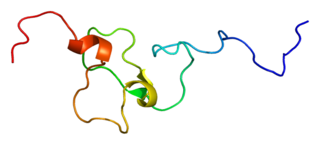V-set domain-containing T-cell activation inhibitor 1 is a protein that in humans is encoded by the VTCN1 gene. [5] [6] [7]
V-set domain-containing T-cell activation inhibitor 1 is a protein that in humans is encoded by the VTCN1 gene. [5] [6] [7]
B7H4 belongs to the B7 family (see CD80; MIM 112203) of costimulatory proteins. These proteins are expressed on the surface of antigen-presenting cells and interact with ligands (e.g., CD28; MIM 186760) on T lymphocytes.[supplied by OMIM] [7]
B7-H4 is an immune checkpoint molecule.

The C3a receptor also known as complement component 3a receptor 1 (C3AR1) is a G protein-coupled receptor protein involved in the complement system.

Palate, lung, and nasal epithelium clone protein (PLUNC) is a gene encoding a secretory protein. It is also called Secretory protein in upper respiratory tracts (SPURT). In humans, it is encoded by the BPIFA1 gene, previously called PLUNC.

Interleukin 6 receptor (IL6R) also known as CD126 is a type I cytokine receptor.

MHC class I polypeptide–related sequence A (MICA) is a highly polymorphic cell surface glycoprotein encoded by the MICA gene located within MHC locus. MICA is related to MHC class I and it has similar domain structure, however, it is not associated with β2-microglobulin nor binds peptides as conventional MHC class I molecules do. MICA rather functions as a stress-induced ligand (as a danger signal) for integral membrane protein receptor NKG2D ("natural-killer group 2, member D"). MICA is broadly recognized by NK cells, γδ T cells, and CD8+ αβ T cells which carry NKG2D receptor on their cell surface and which are activated via this interaction.

Programmed death-ligand 1 (PD-L1) also known as cluster of differentiation 274 (CD274) or B7 homolog 1 (B7-H1) is a protein that in humans is encoded by the CD274 gene.

T-box transcription factor TBX21, also called T-bet is a protein that in humans is encoded by the TBX21 gene.

Psychosine receptor is a G protein-coupled receptor (GPCR) protein that in humans is encoded by the GPR65 gene. GPR65 is also referred to as TDAG8.

Serine/threonine-protein kinase Sgk3 is an enzyme that in humans is encoded by the SGK3 gene.

ICOS ligand is a protein that in humans is encoded by the ICOSLG gene located at chromosome 21. ICOSLG has also been designated as CD275.

Inhibitor of growth protein 4 is a protein that in humans is encoded by the ING4 gene.

Cluster of Differentiation 276 (CD276) or B7 Homolog 3 (B7-H3) is a human protein encoded by the CD276 gene.

Activating transcription factor 5, also known as ATF5, is a protein that, in humans, is encoded by the ATF5 gene.

Fibrinogen-like protein 2, also known as FGL2, is a protein which in humans is encoded by the FGL2 gene.

Nucleoporin 54 (Nup54) is a protein that in humans is encoded by the NUP54 gene.

Protein YIPF5 is a protein that in humans is encoded by the YIPF5 gene.

Ankyrin 1, also known as ANK-1, and erythrocyte ankyrin, is a protein that in humans is encoded by the ANK1 gene.

CREB-regulated transcription coactivator 3 is a protein that in humans is encoded by the CRTC3 gene.

Neuregulin 3, also known as NRG3, is a neural-enriched member of the neuregulin protein family which in humans is encoded by the NRG3 gene. The NRGs are a group of signaling proteins part of the superfamily of epidermal growth factor, EGF like polypeptide growth factor. These groups of proteins possess an 'EGF-like domain' that consists of six cysteine residues and three disulfide bridges predicted by the consensus sequence of the cysteine residues.

CD96 or Tactile is a protein that in humans is encoded by the CD96 gene. CD96 is a receptor protein which is expressed on T cells and NK cells and shares sequence similarity with CD226. The protein encoded by this gene belongs to the immunoglobulin superfamily. It is a type I membrane protein. The protein may play a role in the adhesion of activated T and NK cells to their target cells during the late phase of the immune response. It may also function in antigen presentation. Alternative splicing occurs at this locus and two transcript variants encoding distinct isoforms have been identified. CD96 is a transmembrane glycoprotein that has three extracellular immunoglobulin-like domains and is expressed by all resting human and mouse NK cells. CD96 main ligand is CD155. CD 96 has approximately 20% homology with CD226 and competed for binding to CD155 with CD226.

NLRC5, short for NOD-like receptor family CARD domain containing 5, is an intracellular protein that plays a role in the immune system. NLRC5 is a pattern recognition receptor implicated in innate immunity to viruses potentially by regulating interferon activity.